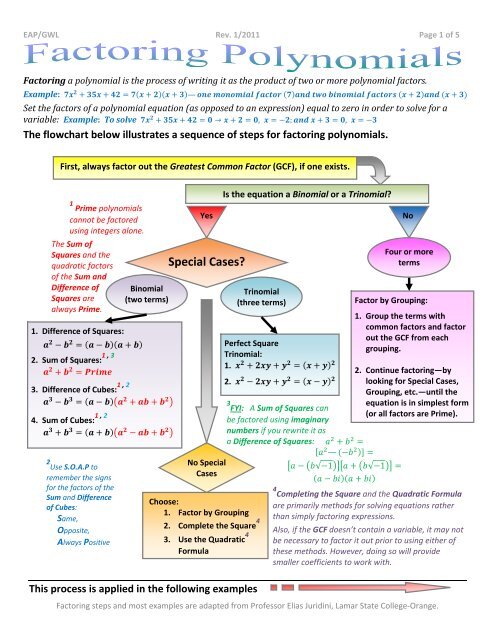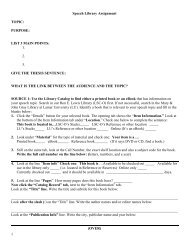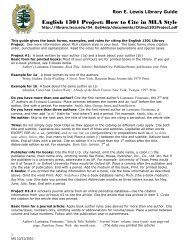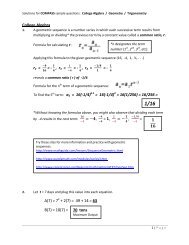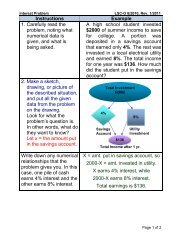Factoring Polynomials (Flowchart with Examples) - Lamar State ...
Factoring Polynomials (Flowchart with Examples) - Lamar State ...
Factoring Polynomials (Flowchart with Examples) - Lamar State ...
Create successful ePaper yourself
Turn your PDF publications into a flip-book with our unique Google optimized e-Paper software.
EAP/GWL Rev. 1/2011 Page 1 of 5<br />
<strong>Factoring</strong> a polynomial is the process of writing it as the product of two or more polynomial factors.<br />
Example: — <br />
Set the factors of a polynomial equation (as opposed to an expression) equal to zero in order to solve for a<br />
variable: Example: To solve , ; , <br />
The flowchart below illustrates a sequence of steps for factoring polynomials.<br />
First, always factor out the Greatest Common Factor (GCF), if one exists.<br />
1 Prime polynomials<br />
cannot be factored<br />
using integers alone.<br />
The Sum of<br />
Squares and the<br />
quadratic factors<br />
of the Sum and<br />
Difference of<br />
Squares are<br />
always Prime.<br />
1. Difference of Squares:<br />
<br />
2. Sum of Squares: 1 , 3<br />
<br />
3. Difference of Cubes: 1 , 2<br />
<br />
4. Sum of Cubes: 1 , 2<br />
<br />
2 Use S.O.A.P to<br />
remember the signs<br />
for the factors of the<br />
Sum and Difference<br />
of Cubes:<br />
Same,<br />
Opposite,<br />
Always Positive<br />
Binomial<br />
(two terms)<br />
Yes<br />
Special Cases?<br />
No Special<br />
Cases<br />
Trinomial<br />
(three terms)<br />
Choose:<br />
1. Factor by Grouping<br />
2. Complete the Square 4<br />
3. Use the Quadratic 4<br />
Formula<br />
This process is applied in the following examples<br />
Is the equation a Binomial or a Trinomial?<br />
Perfect Square<br />
Trinomial:<br />
1. <br />
2. <br />
<strong>Factoring</strong> steps and most examples are adapted from Professor Elias Juridini, <strong>Lamar</strong> <strong>State</strong> College‐Orange.<br />
No<br />
Four or more<br />
terms<br />
Factor by Grouping:<br />
3 FYI: A Sum of Squares can<br />
be factored using imaginary<br />
numbers if you rewrite it as<br />
a Difference of Squares:<br />
<br />
<br />
<br />
—<br />
<br />
√1 √1 <br />
<br />
1. Group the terms <strong>with</strong><br />
common factors and factor<br />
out the GCF from each<br />
grouping.<br />
2. Continue factoring—by<br />
looking for Special Cases,<br />
Grouping, etc.—until the<br />
equation is in simplest form<br />
(or all factors are Prime).<br />
4 Completing the Square and the Quadratic Formula<br />
are primarily methods for solving equations rather<br />
than simply factoring expressions.<br />
Also, if the GCF doesn’t contain a variable, it may not<br />
be necessary to factor it out prior to using either of<br />
these methods. However, doing so will provide<br />
smaller coefficients to work <strong>with</strong>.
EAP/GWL Rev. 1/2011 Page 2 of 5<br />
Binomials:<br />
<strong>Factoring</strong> <strong>Examples</strong><br />
1. : First, divide each term by the to get the <br />
<br />
.<br />
<br />
Then, show the multiplied by the .<br />
No special cases apply to the binomial , so the factors are and .<br />
Factored: <br />
2. : This polynomial expression has no .<br />
However, it can be expressed as a : .<br />
Use the square root of each term, and √16 4 to fill in the formula:<br />
, …<br />
<br />
<br />
Continue to factor another : .<br />
The next factor is a , which is .<br />
Factored: <br />
<br />
3. : Theres no to factor out, but you<br />
should recognize this polynomial expression as<br />
a : <br />
.<br />
<br />
<br />
Use the cube root of each term, 729 <br />
9 <br />
<br />
√1 1 to fill in the formula:<br />
<br />
<br />
• In the first set of parentheses, place each term to the first power: 9x 1.<br />
• In the second set, square the first and the last term: 9x ? 1 <br />
o The middle term is the product of the first and the last: 9x 9x1 1 <br />
o *Note that this quadratic factor is Prime!<br />
• Use S.O.A.P to remember the sign s : Same in first set of parentheses; Opposite, followed by<br />
Always Positive in second set of parentheses.<br />
If and ,then …<br />
<br />
<br />
Trinomials:<br />
Factored: .<br />
1. : There’s no GCF to factor out of this expression, so check for a Perfect Square<br />
Trinomial—<br />
or <br />
ASK: •Are the first and the last terms perfect squares? and — !<br />
•Is the middle term two times the product of the square roots of the first and last terms?<br />
<strong>Factoring</strong> steps and most examples are adapted from Professor Elias Juridini, <strong>Lamar</strong> <strong>State</strong> College‐Orange.
EAP/GWL Rev. 1/2011 Page 3 of 5<br />
First Term √<br />
, Last Term √4<br />
, and — !<br />
If “Yes” to both of the above:<br />
•Place the square roots of the first and last terms in parentheses: ? 2<br />
•Use the sign of the middle term: 2<br />
•Square the whole thing: 2 <br />
<br />
Factored:<br />
If and √4 ,then …<br />
<br />
<br />
<br />
2. : Factor out the , , in this equation to get .<br />
Be sure the trinomial fa ctor isn t a special case— it isn t— and select a factoring metho d.<br />
a. Try Grouping:<br />
• First, multiply the coefficient of the first term, 2, and the constant, 10: 2•10=20.<br />
• Then find t he factors of this prod uct, 20, that add/subtract to yield the coefficient o f the<br />
middle term, which is 1.<br />
Factors of 20: 1•20, 2•10, an d 4 •5. Of these factors, 4 and 5 will subtract to give 1.<br />
Because the middle term is positive, we use +5 and –4.<br />
• Replace the middle term <strong>with</strong> –4 and +5: .<br />
o It’s important to order the two new middle terms so a GCF can be factored from<br />
each pair: , but not .<br />
• Group the first and last pairs of terms; factor out a GCF from each, and rewrite the problem:<br />
2 4 5 10 2 2 5 2 .<br />
o Note that appears twice. If this doesn’t happen, reorder your middle terms.<br />
• Factor out the GCF—which is —and rewrite in factored form.<br />
<br />
• Remember to include the 2 factored out at the beginning when you write the whole<br />
equation in factored form<br />
( ) Factor by Grouping ( )<br />
Factored: <br />
• Recall that this example is an equation set equal to zero (not simply an expression). That<br />
means we can solve for x by setting each facto r containing a variable equal to zero.<br />
or <br />
or <br />
<br />
Solutions: or<br />
*Always check by plugging your answers into the original equation to verify them!<br />
<br />
<br />
b. Now let’s solve the same equation, , by Completing the Square:<br />
• Make sure the equation is in the General quadratic Form— —and it is.<br />
• The GCF is 2, but you don’t need to factor it out—doing so will not affect the solutions.<br />
<strong>Factoring</strong> steps and most examples are adapted from Professor Elias Juridini, <strong>Lamar</strong> <strong>State</strong> College‐Orange.
EAP/GWL Rev. 1/2011 Page 4 of 5<br />
• Divide each term by the first term’s coefficient unless the first coefficient is already 1:<br />
<br />
220<br />
<br />
2<br />
<br />
20<br />
<br />
• Isolate the constant on the right side of the equal sign. Then take ½ the middle term’s<br />
coefficient multiply by ½ o r divide by 2, square it, and add this number to both sides of<br />
the equation:<br />
1<br />
<br />
<br />
5505 <br />
2 <br />
The is 1 <br />
Take of and sq uare it: 1 <br />
1<br />
1 <br />
2 2 2 4 1<br />
4 <br />
1 <br />
Add to both sides: <br />
5 <br />
2<br />
<br />
<br />
<br />
o<br />
□Completing the Square□<br />
<br />
Use a common denominator t add fractions: <br />
<br />
• <br />
<br />
<br />
Now we have <br />
<br />
, which is a<br />
<br />
Pe rfect Square Trinomia l on the left.<br />
*The point of Completing the Square is to create a Perfect Square Trinomial!<br />
Compare <strong>with</strong> the formu la: <br />
In <br />
, √ and <br />
<br />
T he middle t erm is <br />
<br />
<br />
<br />
The trinomial can be written as <br />
, so it can be factored as <br />
<br />
• Rewrite the equation <strong>with</strong> the left side factored:<br />
<br />
<br />
<br />
<br />
<br />
• The final step is to ex tract the roots and solve for x:<br />
<br />
<br />
<br />
<br />
<br />
<br />
<br />
or <br />
<br />
<br />
Solutions: or<br />
<br />
*The solutions are the same as obtained from the previous method!<br />
c. Finally, let’s try using the Quadratic Formula to solve the equation :<br />
Quadratic<br />
√ <br />
Formula<br />
<br />
<br />
• Factor out the GCF to get .<br />
<strong>Factoring</strong> steps and most examples are adapted from Professor Elias Juridini, <strong>Lamar</strong> <strong>State</strong> College‐Orange.
EAP/GWL Rev. 1/2011<br />
Page 5 of 5<br />
• Note that factoring out the 2 will not affect the solutions, but it does result in smaller<br />
coefficients to plug into the Quadratic Formula.<br />
• Make sure the equation is in General quadratic Form, , and it is.<br />
• Identify a, b, and c in : , , <br />
• Plug these numbers into the formula and solv e for x:<br />
Quadratic Formula<br />
More Than Four Terms :<br />
√ <br />
<br />
<br />
<br />
<br />
<br />
<br />
<br />
<br />
√<br />
<br />
<br />
<br />
<br />
<br />
<br />
or <br />
<br />
Solutions: or <br />
*Again, we obtain the same soluti<br />
ons as we did by other methods!<br />
1. : Factor the expression by Grouping and continue factoring until<br />
completely simplified.<br />
• Factor out the GCF , 5, to get and then group the terms so that<br />
another GCF can be rem<br />
oved from each grouping.<br />
<br />
• We are unable to obtain a pair of identical binomial factors (as in the earlier Grouping<br />
example). Therefore, no further factoring is possible and we see that the expression has only<br />
two factors, 5 and .<br />
Factored: <br />
2. <br />
: The terms of this expression appear to need no rearrangement. The first pair,<br />
, are a Difference of Squares and the second pair, , have a GCF of 3:<br />
• Factor each pair: <br />
However, there is no GCF to factor out of these pairs of factors. The expression remains the<br />
sum of polynomial products rather than the product of two or more polynomial factors<br />
(the definition of the factored form).<br />
• When one way of grouping doesn’t work, try another . . .<br />
Rearrange the terms t o form a Perfect Square Trinomial and a Difference of Squares:<br />
<br />
• Factor th e Difference of Squares:<br />
<br />
Factored: <br />
This example is<br />
adapted from<br />
Gustafson & Fisk,<br />
College Algebra, 8 th<br />
ed., Thompson<br />
Learning, Inc. 2004,<br />
p. 55.<br />
<strong>Factoring</strong> steps and most examples are adapted from Professor Elias Juridini, <strong>Lamar</strong> <strong>State</strong> College‐Orange.


